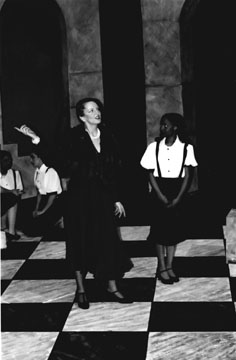“Romeo and Juliet” A New Look for an Old Classic

Congrats to Graduates
April 2, 2003
This year’s Shakespearean performance brought with it a new look at an old favorite in the world of dramatic tragedies: “Romeo and Juliet.” Making her directorial debut is the Technical Director and Designer for the Performing Arts Department Laura Schrader, transporting this Elizabethan period piece to pre-World War II fascist Italy. The play opens with cheers of adoration for the infamous Benito Mussolini and goes into a fight scene between the Capulets and the Montagues reminiscent of “West Side Story,” minus the music.
I’ve seen Shakespeare done at any number of schools, both high schools and colleges and this is, without a doubt, one of the better portrayals of it. The meaning of the language, besides being clearly and concisely spoken, was clearly conveyed with effective body language on the part of the entire cast. This is an impossible task for most shows because most of the actors and actresses don’t understand what they’re saying. This is definitely one cast that knows their onions, peas, and carrots.
The frilly Renaissance dialogue goes a long way towards turning most people off of one of the English language’s greatest writers; they find it nearly impossible and tedious to decipher the colloquialisms and metaphors that make the Bard’s work so powerful. To make Shakespeare more user-friendly, they create trite adaptations such as “Ten Things I Hate About You,” based on “The Taming of the Shrew,” or “O,” based on “Othello.” Modern dialogue grouped with teenie-bopper angst helps to effectively mute any feelings the work might evoke from the audience. It becomes another mindless piece of drivel for the likes of pop culture youth too lazy to bother with appreciating the work as it is.
The stage chemistry between Romeo (Matthew Gianino) and Juliet (Marta Johnson) went a long way towards making this poignant romance more than just an adolescent love affair, as it would be with less talented actors. The schizophrenic Mercutio, played by Paul Norton, the stentorian Friar Lawrence, played by Brian James Ward, and the witty and wanton Nurse, played by Eileen Rooney, made these usually secondary roles stand out more due to the actors’ ability to present a fully developed character without the benefit of as many lines as the main players.
“I was very impressed with the Nurse’s role, and she was always acting even when she didn’t have a line,” commented audience member and student Holly Perreault. “I also thought they did an excellent job with set design and utilizing what space they had.”
A minimal set, consisting of two benches, three entry-ways, and a set of steps served as the only backdrop for the entire production. Since Schrader’s tenure, simplicity in themes has marked the past few productions, like “Alice in Wonderland” and “Cinderella Waltz.” Keeping the set manageable can be difficult and building a large set is time-consuming; this convenient style retains elegance in the checkerboard design and fluted Roman columns of Juliet’s requisite balcony.
The age-old family feud, sealed and settled with the blood of their children, normally runs for three hours but went for two the opening night. The biggest problem for most casts is their age; youth does not always have the benefit of having had too many experiences, thus they are incapable of understanding the motivations behind much of the characters’ actions. “Romeo and Juliet” presents the actor with a unique challenge; the impetuousness of youth and the adult behavior associated with handling responsibility crammed into the space of roughly four days.
However, the UMass Boston cast had no problem reaching deep within to figure out the secret to Shakespearean success, as was clearly shown by the way they were able to handle and channel their emotions into a powerful performance. They look to follow up this triumph with the Bard in their performance of the comedy “Twelfth Night” which will go on from May 7-10 at 8pm in McCormack Theatre.























































